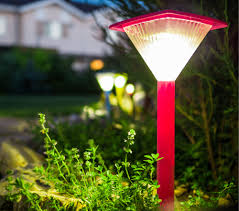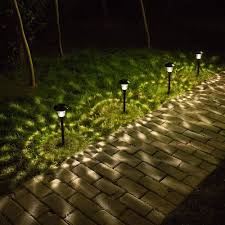Solar Landscape Lighting (Pros and Cons)
Outdoor lighting is an essential part of landscape design and something that every home needs. Landscape lighting increases safety, enhances your home security measures, guides traffic through your yard, accentuates interesting features of your home or yard, provides task lighting and illuminates your outdoor living areas.
So, really, the only question is which type of outdoor lighting is right for you. The three basic categories are solar, halogen and LED. Here, we will look at the pros and cons of solar landscape lights, but be sure to also read Halogen vs LED Landscape Lighting to help you determine the right lighting product to best suit your needs.
Benefits of Solar Landscaping Lighting
First, let’s take a look at some of the pros of choosing solar-powered landscape lighting for your patios, walkways, driveway, flowerbeds or garden.
- You don’t need a nearby source (or any source) of electricity for your lights.
- Because you do not need electricity, you can place your landscape lights almost anywhere that receives adequate sunlight throughout the day.
- Your landscape lighting will not increase your electricity bill.
- In the summer months when the days are longer, your lights will stay on longer into the night, which may be a benefit during this popular season for entertaining.
- You can install your lights in a flowerbed or vegetable garden where you frequently dig without worrying about damaging electrical wires.
- Because no wiring is required, solar landscape lights are easy to install and can be a do-it-yourself project.
- Other than your upfront investment, you can expect to spend little to no money during the lifetime of your solar lights. This is because they do not require electricity and have minimal maintenance needs.
- Because they do not require electricity, solar yard lights are an eco-friendly choice that can help lower your home’s carbon footprint.
- You do not have to worry about your children or dogs cutting, chewing through or tripping on electrical wires.
Cons of Solar Landscape Lighting
Now that we have gone over the potential benefits of choosing solar landscape lights, let’s look at some of the cons of solar lighting to help you determine if this is the right type of yard lights for you.
- Solar landscape lights must be placed where they will receive light throughout the day to charge the batteries.
- Solar landscape lighting is generally not a viable option in areas with trees, shrubs, bushes, plants that block the sun.
- Solar lights often cannot be used near structures that block the sun for a significant part of the day.
- The solar panels must be cleaned regularly to remove dust and debris that can block the sunlight needed to charge the batteries.
- Most solar lights will not stay on as long as other landscape lighting options after nightfall on cloudy days due to not receiving enough sunlight to charge the batteries fully.

Questions about Solar Lighting:
How does outdoor solar lighting work?
Solar-powered lights each contain a solar cell, Ni-Cad rechargeable battery, LED light and photoresistor. Essentially, each light’s solar cell produces energy, which charges the battery during the day. Solar-powered lights stop producing energy at night, so the photoresistor, which detects the absence of light, activates the battery, which turns the LED light on.
What are the benefits of outdoor solar lighting?
Simple installation is the best reason to choose them. They don’t require any wiring or other power sources, making it easy to place them in the ground. You’ll also be grateful when your power bill comes since these lights aren’t using electricity. Safety is another reason to choose solar lights. Since they don’t use power cords or electricity, they are safe for use near ponds or swimming pools.
How long does outdoor solar lighting last?
The Ni-Cad rechargeable batteries will last about two years if you take care of them and periodically allow your lights to recharge. Replacement batteries can also be ordered from the manufacturer or online. The LED light bulbs will run up to 100,000 hours each and are not replaceable.
How do I take care of my outdoor solar lighting?
Because solar lights are powered by direct sunlight, they need to be cleaned periodically from dust or mud, so they can easily store energy for the night. They also do not work as well during the winter or on cloudy days, so you may want to store your them indoors during rainy or snowy seasons. Switch them to the off position when they are not being used and store them in a dark place.
Is outdoor solar lighting weatherproof?
While solar lights are designed for all temperatures, the models that include glass should not be left outdoors if you receive a lot of rain or snow. They should not be exposed to windstorms or extreme storms, either, as they can easily be damaged. You can buy hanging fixtures if you’re worried about your lights blowing away; hanging lights also work well for lining swimming pools, ponds and creeks.

Things To Do If Your Solar Powered Lights Aren’t Working
Now we are big fans of solar lights, but we do understand that they can cause some people a lot of issues. If you’re struggling with yours then try out a couple of our handy tips to see if you can get them working again.
1. Check that they’re turned on
You would be surprised how often people haven’t realised that their lights have an on/off switch (not all of them do).
2. Check that there’s not a pull tab on the battery
This will apply to newly purchased lights only. Sometimes there is a pull tab on the battery that needs to be removed before the light will function. If your new light doesn’t work, definitely check on this.
3. Cover the panel to test the light
Generally speaking, solar powered lights do not work during the day. In order to test if the light is working, you will need to completely cover the solar panel to simulate darkness.
4. Ensure the solar panel is clean
A dirty panel can impact the amount of charge received. See our guide on how to clean your solar panel.
5. Make sure the solar panel is positioned correctly
The panel should be positioned to receive sunlight all (or at least most of the) day, or else it might not be receiving sufficient charge. Do solar lights need direct sunlight to work?
6. Test with regular batteries if possible
In most instances of solar powered lights not working, it is the batteries at fault. Either they are not receiving charge or they are not holding it. If the lights work using normal batteries then it is clear that the problem is with either the rechargeable batteries or the solar panel.
7. Switch off and leave to charge for 72 hours
Many solar powered lights will still charge if they are not turned on, and by turning them off you actually allow the battery to get a full charge over several days of sunlight. It is an idea to do this regularly with solar lights.
8. Contact the retailer
If all else fails, contact the retailer that your purchased your lights from. All of our lights have a 12 month warranty. So, if you’ve tried the above steps and bought your lights from us within the last 12 months contact us or view our full returns policy.

Can you Charge Solar Lights Without Sun?
Yes! It is certainly possible to charge solar lights (like these solar lanterns) without direct sunlight. There multiple methods to do this. Although they are not as efficient as bright sunlight would be in charging the battery, they will all work to regenerate the charge located in the battery and bring the solar light back to life in a pinch.
How to Charge Solar Lights Without Sun
1. In indirect sunlight
One might think that cloud cover is a death knell for solar-powered everything. One would be incorrect in that assumption. While direct, bright sunlight is the preferred way to regenerate a solar light battery, even indirect sunlight will work to charge the light. Remember when we said that photons knock the electrons off of the phosphorus-doped silicon atoms? That remains the case in indirect sunlight. There are just fewer photons to go around. In indirect sunlight, photons will still strike the solar panels, they will just do so less often and, therefore, charge the solar light battery slower than direct sunlight would.
2. Use artificial lighting
Artificial lighting, while much less powerful than sunlight, will charge a solar light battery. This means you can take the solar light inside and place it near an LED or incandescent bulb and expect the solar light batter to charge, albeit quite slowly. The same principle that keeps the battery charging during periods of indirect sunlight holds true in this case. The indoor lights that illuminate our rooms utilize photons just like the sun. They will also knock electrons loose from the silicon atoms in the solar panels.
We should note specifically that both LED and incandescent lights will operate to charge a solar light battery. You do not need to seek out one over the other. Either will do the trick.
3. Use the alternative charging method
Many solar lights, both indoor and outdoor, come with alternate charging methods. Frequently, these are USB or wall outlet ports that allow you to plug the solar light into a USB charger, computer or wall socket to charge the internal battery. Use the opportunity whenever it is convenient to fully charge the solar light (perhaps by using one of these solar power banks) by this method since it will typically be much faster than waiting for it to charge by solar panel, even in direct sunlight. Of course, if you purchased the solar light specifically to avoid using “on-the-grid” power solutions you may not wish to do this.
Tips to Prolong the Life of Your Solar Lights
Solar lights last, on average, about two years before the batteries must be replaced. However, there are a few ways to ensure they last a while longer.
- Make sure to clean your solar lights regularly by wiping them with a clean cloth about every two weeks
- Replace the batteries if the lights are unable to provide light for 8 hours
- Turn lights off and store in a cool environment with some access to sunlight during extreme weather
- Be cautious of placing lights in garden areas, as dirt buildup can prevent them from receiving adequate power
Make sure to turn lights off when they will not be exposed to light for long periods of time